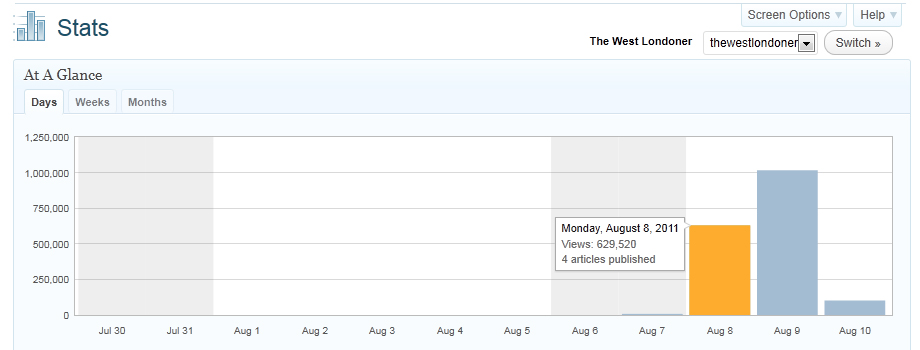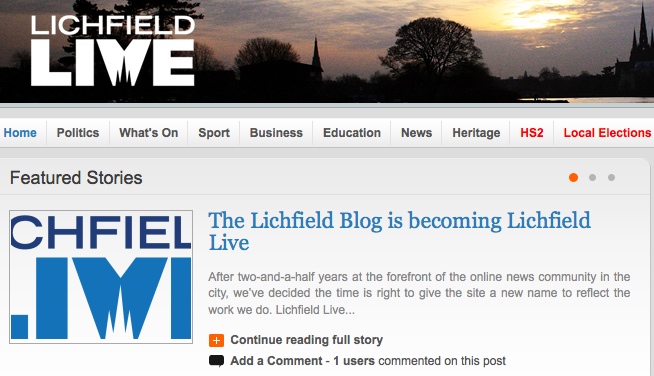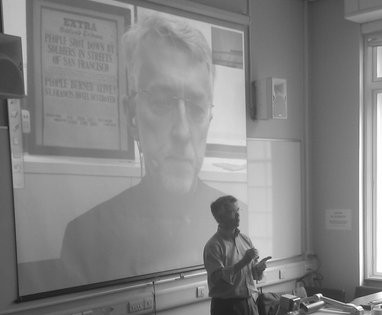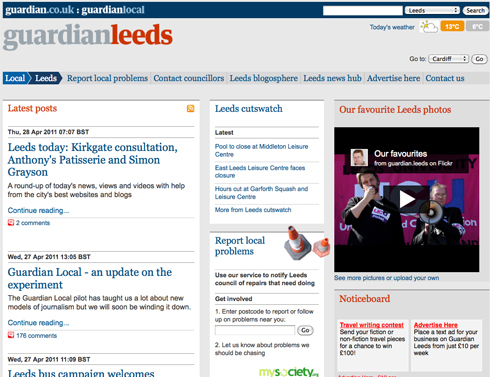When the riots broke out in London and beyond last weekend, the press worked hard to keep up with the latest accounts and rumours circulating. And it was not just the national press and local papers bidding to bring audiences the latest from the heart of the action, the riots also proved an extraordinary experience for student journalists keen to flex their online reporting muscles.
On the fourth night of riots in the city and beyond, Journalism.co.uk caught up with MA journalism student at Brunel University Gaz Corfield, editor of hyperlocal site the West Londoner. Corfield and his team of contributors produced a live-blog of the events on the WordPress blog which, according to Corfield, enjoyed a tremendous 1 million views in just 24 hours (see graph below).

Below Corfield explains how the team approached coverage of the events, why he thinks the live blogging formula worked so well, and how him and his team of contributors helped verify and check reports.
Why a live-blog?
From the feedback we’ve had it seems that speed and accuracy of coverage is what makes the liveblog format popular. Full length news stories are great for catching up on events when you’re having a leisurely read about them the day afterwards. However, when the situation is fluid and still developing, readers want immediate updates. It takes time even to write up a NIB and you may not have enough information to pad out a story. Devoting a separate page on your website to four and a half lines with a break in the middle isn’t very informative. Some of our readers were interested in the earlier reports and with the liveblog format those are easily accessible just by scrolling down the page.
What challenges did you face while covering the riots, both in terms of safety and technological?
Our people on the ground have mainly been friends and volunteers who got in touch and offered their services. The vast majority of what we’re doing is curating reports from Twitter but having our own people on location has helped. One of our contributors, Sarah Henry, was in Hackey on Tuesday and was briefly caught up the violence there but got away unscathed – she tells me that the BBC reporter next to her was hit by a bottle.
Twitter, Twitpic and Yfrog have all been essential to our services and I really cannot recommend TweetDeck enough; the ability to set up live-updating searches was a true godsend. The biggest challenge, though, has been keeping the updates going out onto the site. You can have all the people and apps in the world bringing you information but at the end of the day, someone’s got to type them up!
What made your coverage stand out from others?
Speed, accuracy and collation of information from the ground, sifting between rumours and facts. Debunking false rumours, where we felt confident enough to do so, also built up our readers’ trust quickly. We weren’t afraid to categorise our reports – if we had sketchy information about something, we’d tell our readers “this report is unconfirmed” and work as quickly as we could to either confirm or deny it.
We also made a conscious choice not to label the people we were reporting on, even though our sources mentioned vigilantes, ethnic groups and political groups. Given the already heightened situation I felt it would be irresponsible to put out sensitive information we couldn’t directly check ourselves, so we stuck to just reporting movements of people. I think our readers appreciated that; our coverage was seen as being purely factual without any speculation, and therefore more valuable than other sources. I refused to report rumours about intended targets, which I think reassured a lot of people.Rapid and relevant updates are what seems to be driving the traffic – at the end of Tuesday night/Wednesday morning the traffic was dropping off as there simply wasn’t anything new to report on. We also had the huge advantage of being the first liveblog to have up-to-the-minute reports. At the beginning of the riots there were repeated rumours that there was a news blackout, and many people were expressing frustration at their usual go-to news outlets being behind the curve.
How were you verifying breaking news/images/video etc?
We put a lot of trust in images. Provided they were tweeted alongside a location-specific hashtag we took them seriously – although this did go slightly awry when someone produced fake pictures of the London Eye on fire! Videos more or less spoke for themselves – either you can recognise local landmarks, or you can’t. Google Street View was useful for verifying images and videos in less frantic moments.
Sorting through tweets was harder – although we had our trusted sources out on the ground at the beginning, as the night progressed we had to read through public Tweets and decide what was real and what was just rumour. If we had a lot of similar (but not identical) reports of activity in a given area, we tended to treat that as reliable. However, that did get confusing towards the small hours of Wednesday morning because our own information was immediately being picked up and distributed by Twitter users in the areas we were trying to learn more about. Our biggest challenge was filtering out retweets because they clogged our information flow.
How did you use social media to further your reporting?
We used Twitter and Facebook. One person dedicated to running each, plus myself on the liveblog. It did get quite tricky deconflicting information going out from both sources. When I first built the site I set our Facebook page’s updates to autopost on Twitter, which later made us wonder where some of our own tweets were coming from! Close co-ordination kept the feeds unique and interesting, though.
We established a conversation with our readers on Facebook, using our page there to respond to queries about riots in peoples’ local areas. Our Twitter feed was pushing out shortened versions of the liveblog updates, with regular links to the liveblog page. In quieter periods we also published our Twitter username and asked for tip-offs to be directed at that, which worked well. Surprisingly, we also received a large volume of tip-offs through the email contact form on our website; you don’t really think of email as being a form of social media but clearly it has its place.



